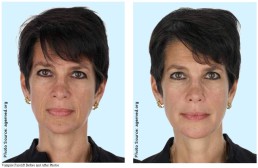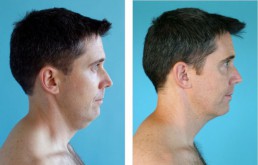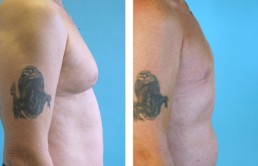Vaser Lipo Swelling, Bruising, and Numbness
How Long Does Vaser Lipo Swelling Last?
At the Dr. Alexandra Chambers Medical and Aesthetic Practice, one of our most popular treatments is Vaser Liposuction, a low-impact body sculpting procedure. In our clinic, we typically remove on average three to four litres of sub-dermal fat, and the target areas are varied, including the abdomen, ankles, arms, back, buttocks, chest, chin, flanks, jowls, knees, neck, and thighs.
Vaser lipo surgery is performed with a local anaesthetic, and thanks to its pulsed ultrasound technology, it is very efficient at liquefying and removing fat. This is in contrast to traditional liposuction, which requires general anaesthesia, and in general, is a much less effective fat removal method. The result is that Vaser is safer, less expensive, providing better more controlled results, and, post-operatively, is much lower impact. It is lower impact because the body recover faster from local anaesthesia, and because the skin layer suffers much less trauma. Thanks to these reasons, it is typically possible to resume one’s normal life within a day of a Vaser operation.
That said, as with any surgical procedure, there will be post-operative swelling, bruising, and numbness, and for some patients these can be a cause of distress. Although during our consultation process we explain in significant detail what can be expected, patients typically are quite concerned. Moreover, we have noted that this topic interests patients from other clinics, as we have observed from the numerous questions about it on a wide variety of online forums and social networks.It is for these reasons we’ve compiled clinical data for a sample of 129 Vaser procedures from our own clinic, and have assembled the statistics on post-operative swelling, bruising, and numbness. The results, presented below, provide a clear picture of what can be expected, and we now make use of these figures to better communicate and reassure our own patients. Hopefully they will also be of use to others.In interpreting the results we present below, note that in addition to the use of compression garments, we offer all our patients manual lymphatic drainage massage as a standard part of our post-operative care. We believe, this significantly shortens the duration of swelling.
The first graph we present illustrates the statistics for Vaser lipo swelling to subside. The vertical height of the bars gives the percentage of patients having their swelling subside by the number of days shown under the bar on the horizontal axis. It shows that the most common duration is 16 days, and this was the case for 40% of our patients. The graph also indicates that 2% of our patients required up to 44 days (over six weeks) before swelling subsided, whereas 2% of them also required only 4 days to get over being swollen after a Vaser treatment.
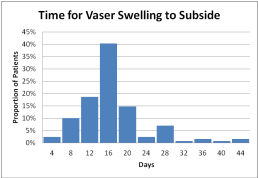
The second graph illustrates the cumulative percentage of patients recovering from swelling after Vaser lipo. It shows that half our patients need 14 days to recover from swelling, and that 90% of our patients have recovered from swelling after 24 days. That’s to say that 13 of the 129 patients from this sample required more than three and a half weeks before swelling subsided. This shows that a significant number of patients will have long swelling after their operations.
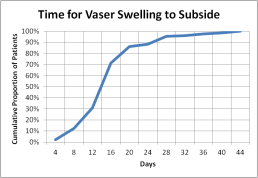
The third graph shows the stats for Vaser lipo bruising to subside. The most common duration was 16 days (30% of patients), whereas one patient required 36 days.
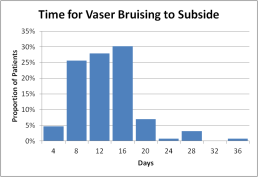
The fourth graph show that 50% of our patients were over bruising caused by Vaser lipo after 11 days, and that 90% of them were over it after 16 days.
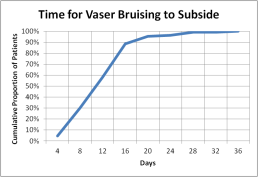
The fifth graph show the statistics for numbness to subside after a Vaser operation. It shows that 16 days was the most common (25.5%), but that a significant number still had numbness up to 32 days after their procedure.
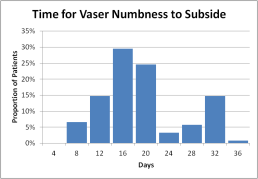
The sixth and final graph shows that 50% of our patients were over numbness after 16 days, while 90% after 30 days.
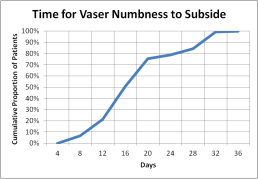
Swelling of Vaser Liposuction versus Traditional Liposuction
How Much Swelling Can I Expect From Vaser Lipo?
Liposuction is a popular cosmetic surgery procedure that effectively removes fat from underneath the skin. Most procedures involve one of two popular methods; traditional liposuction or VASER liposuction.
Vaser lipo uses ultrasound waves to break up fat after which it is removed by traditional suction methods. Traditional liposuction involves breaking up the fat by sticking a tube or cannula to give it its medical term, under the skin and passing it backwards and forwards. This process involves incisions to be made in the skin and can be quite rough on the areas being treated.
Vaser is a much more gentle way of breaking up fat and therefore less swelling will be apparent once the procedure is complete. However, it is important to remember that Vaser liposuction is a surgical procedure and that some swelling is normal and to be expected. The results of liposuction are well worth the short period of discomfort you may feel during the period before the swelling disappears.
Recovery times after Vaser are much quicker than when compared with traditional liposuction. In fact, Vaser patients are able to partake in light exercise after only a few days, and within a couple of weeks there should be no reason why normal activities including lifting and strenuous exercise cannot be resumed. Any dressings should still be kept on for up to six weeks in order to protect the area from infection.
The trauma experienced with Vaser is so much less than with traditional methods of liposuction that it is fast becoming one of the more popular cosmetic surgery procedures. People no longer have time stay home in bed to recover… Vaser is a low-impact procedure, after which lets patients get on with their lives.
With Vaser there is no need for strong painkillers or anti-inflammatory drugs as the procedure is so much gentler on the body and therefore only slight discomfort should be experienced. Whilst there will be some localised swelling this should disappear after a few days as your body naturally heals the treated areas.
The best way to get an idea about recovery times is to read our recently published clinical survery on the duration of swelling, bruising, and numbness after Vaser lipo. You can also speak to your consultant or surgeon. They will be able to help you put aside any fears, show you before and after photos, and explain the procedure in great detail so that you know exactly what to expect.
What is a Vampire Facelift?
The so-called Vampire Facelift has been in the news recently, and this article explains more about what this approach is, and the benefits it provides.
Platelet enriched fat combined with synthetic dermal fillers for tissue loss replacement is an approach gaining in popularity amongst cosmetic doctors, and the Vampire Facelift is just one of a number of procedures based on these techniques.
Platelets are blood cells rich in biologically active Growth Factors (GF) that stimulate and control cell growth, division, and repair. The best known are Platelet Derived Growth Factor (PDGF) and Transforming Growth Factor (TGF). The former acts as a signalling mediator for chemotaxis – purposeful migration of cells specialising in repair to the site of an injury. TGF stimulates synthesis of inter-cellular matrix proteins, which provide a support scaffolding for cells. Other GFs produced by platelets include Basic Fibroblast GF, Insulin-Like GF, Platelet derived Epidermal GF, and Vascular Endothelial GF. All of these are involved in promoting tissue repair and growth by controlling cell proliferation.
The innovation of these procedures is that the platelets used are obtained from the patient’s own blood. The needed cells are extracted from other blood factors by centrifuging. The platelet end-product is a solid, which is cut into small pieces and mixed with a patient’s own fat or, alternatively, with a synthetic dermal filler. The mixture can then be injected into various parts of the body. Thanks to GFs, when the mixture is injected into the face it triggers a natural healing process that thickens the skin, provides more volume, smooths skin surface wrinkles and folds, and can diminish acne scarring.
How Much Does a Vaser Liposuction Procedure Cost?
Vaser lipo prices
The cost of liposuction is an important factor in deciding whether to undergo such a procedure, but in evaluating price, it is also important to consider a number of key factors. These include the level of care, patient safety, the quality of medecines and other materials used, and the experience of the surgeon. These factors all contribute to the aesthetic result, which in the end should be the most important factor of your decision.
If a surgical procedure such as Vaser lipo is being offered at a discount, or seems like an unusually good deal then this article should be of interest to you because we fully outline the essential components contributing to the prices we quote in our clinic. This article complements our main page on on Vaser liposuction.
Fat to be removed
Operating and staffing a surgical theatre is costly, and is typically assessed on an hourly basis. The time needed to perform a Vaser lipo procedure is proportional to the volume of fat to be removed and the density of connective tissue holding it in place. More fat and denser connective tissue means a longer and more arduous procedure. At our clinic, we assess your skin type, and estimate the fat volume to remove using an ultrasound scanner. We measure the fat layer thickness of the areas to be treated, and multiply these by their respective widths and heights to produce an accurate estimate. This provides a consistent and repeatable process for assessing the real staffing and theatre costs needed for your procedure. It means that we won’t be tempted to cut corners once the operation has started because there will be no surprises about the effort needed, and this will have been fairly reflected in the price we quote you.
High-def versus general bodysculpting
The objective of high-def lipo is to remove enough fat so that the muscular structure can be seen. This requires more care and precision than general bodysculpting, and requires more time in the operating theatre. Consequently, prices for high-def lipo are a bit higher.
Staff and materials
For the safety of the patient, we fully staff our operating theatre with a surgeon, assisting doctor, nurse, and when needed, an anaesthetist. This means that your treatment will go more smoothly, with less probability of complications or accidents. Not all practitioners take the same precautions as in our clinic, and this may explain differences in pricing.
In addition, we only use top graded materials during our procedures, as well as bona fide Vaser equipment and probes.
Operating theatre
Many Vaser doctors use public and private hospitals to peform liposuction procedures, which in part can reduce their overall cosrts. However, due to the high volume of sick patients treated in hospitals, from a safety perspective, and in the interests of reducing potential infections for our patients, we manage our own operating theatre.
Post-operative care
Good post-operative care is key to getting a good aesthetic result from Vaser lipo. Monitoring skin retraction, adjusting the compression garments, and assisting the drainage of fluids are all essential to providing top quality after care. For these reasons, we include five post-operative visits in the prices for all our procedures. Click here for more information on our post-operative Vaser liposuction care.
Guidelines
During a face-to-face consultation your surgeon will discuss your objectives, evaluate your suitability, and make the ultrasound measurements needed to give you the best price Vaser lipo procedure (click here to read more about our Vaser consultation process). Each patient is unique, and so a pre-operative consultation is mandatory, both from the view of medical regulation, as well as from the one of safety. However, the following pricing table is fairly accurate, and can provide good guidance on the cost of this type of procedure in our clinic:
| Litres of Fat | General | Dense or High-Def | Dense and High-Def |
| 0.75 | £2,500 | £2,800 | £3,200 |
| 1.50 | £3,200 | £3,800 | £4,500 |
| 3.00 | £4,600 | £5,700 | £7,300 |
| 6.00 | £7,300 | £9,500 | £12,800 |
Thread Lifting FAQ
What is a Thread Lift?
A thread lift is a type of face lift that is often referred to as the “lunch hour lift”. This is down to its simplicity and the time it takes to carry out the procedure. A tiny notch will be made behind the ear or behind the hairline and then fine threads are then advanced along pre-marked contours. These threads have fine filaments that become fixed to the tissue and are then gently smoothed down. Your body then starts to produce new bundles of collagen which surround each filament and this in turn creates a subtle yet effective lift. The results differ for each person, but look very natural giving a rejuvenated and refreshed look. There is no scarring and recovery times are a lot less than those associated with traditional surgery.
What areas can be treated with a Thread Lift?
The thread lift can be used to enhance and improve the appearance of a sagging neck, sagging cheeks and jowls and droopy eyebrows. You can personalise your surgery to suit your exact needs and your doctor will also make recommendations for improvements. The procedure can be tailored to suit your exact needs to ensure you are totally happy with the results.
What are the advantages of a Thread Lift?
The great thing about a thread lift is that it offers quick recovery together with excellent results. This procedure requires a minimum amount of invasive surgery and leaves no scarring. Local anaesthetic is all that is required and there is no hospital stay required. Another good factor about the thread lift is that it is much more affordable than a regular face lift and the results are long lasting. If you are looking for a quick and effective solution to a range of aging problems then a thread lift is the perfect solution.
Who is a Thread Lift Suited For?
A thread lift is more suited to men and women between the ages of 40 and 60. The procedure is most effective on skin that has minimal sagging and offers the best results for cheeks, jowls, brows and the neck area. If you are looking for results that are more effective and long lasting than wrinkle minimising injections and other fillers, then a thread lift is the ideal choice. If you are put off by traditional surgery or don’t want general anaesthetic then a thread lift is great as it is minimally invasive and can be carried out under local anaesthetic.
What are the risks?
No surgical procedure is without risk, but the level of risk is often down to the expertise and experience of the surgeon carrying out your procedure. Thread lifts can cause minor side effects such as infection, bruising, swelling, tenderness, numbness and slight asymmetry. All side effects should be explained in detail to you before the procedure is booked. As long as your doctor is competent, any side effects should disappear within a few days. Another great factor of thread lifts is that they can be reversed if you are not happy or if problems occur.
How long does a thread lift take?
A typical thread lift takes as little as one hour to perform, but the length will depend on the number of filaments your doctor uses and the areas being treated.
What happens after the procedure?
Once the procedure is complete you will be provided with aftercare instructions to follow. These will help to relieve any discomfort and help to speed up the process of healing. For the first 24-48 hours you can use ice compresses to deal with any swelling and help to alleviate discomfort. Most patients experience some mild swelling and bruises, but these are usually quick to settle. Recovery times are usually less than one week although strenuous exercise should be avoided for between 2 and 3 weeks.
How long do the results last?
A thread lift’s lasting power depends on the age of the patient at the time of procedure and how much sagging the thread lift has corrected. It should be noted that sagging will return over time, but many doctors report that the results last for anything between 3 and 4 years. To extend the results it is possible to have additional filaments inserted and your doctor can advise you when this is required.
Are Men Turning More to Cosmetic Surgery?
The Daily Mail thinks so, but according to statistics published on www.surgery.org, there doesn’t seem to be a compelling trend showing this to be true… at least for men in the US.
Some sites on the Internet suggest that the segment of the male population that considers cosmetic surgery are men recently divorced, and wanting a bit more confidence before diving back into the dating scene. However, in the Dr Chambers Medical and Aesthetic Practice in London, UK, men express an interest in looking and feeling better. They are requesting a wide variety of procedures, from mini-facelifts to Vaser Lipo, to a broad range of skin rejuvenation procedures.
Dr Chambers remarks that she hasn’t observed a marked uptick in percentage of men coming to the clinic.
Q&A: Gynecomastia - Questions & Answers or FAQ's
Q. What is Gynecomastia?
A. Gynecomastia is characterised by breast tissue becoming overgrown in the male body. This condition can develop at any age and can be very distressing. The good news is that there are relatively little health risks related with this condition. However, embarrassment and stress can often result from this condition.
Q. What is the cause of Gynecomastia?
A. Gynecomastia is generally caused by an imbalance of hormones. This can be because of a deficiency in testosterone levels or an excess amount of estrogen in the body. Hormone imbalances can be caused naturally or as the result of taking certain drugs or a number of health conditions. Some anti-anxiety and anti-depression medications have been known to cause imbalances of hormones so it may be a good idea to speak to your doctor if you feel your drugs are causing gynecomastia.
Q. How is Gynecomastia diagnosed?
A. The first thing to do when enlarged breasts become a problem is to rule out any other health conditions. Your gynecomastia consultation should begin with a thorough physical examination and check your medical history together with any prescription drugs you are currently taking. Your doctor may request other tests are carried out such as blood tests, mammograms, CT scans and MRIs. This will ensure there are no other underlying causes and that the most suitable treatment can be carried out.
Q. How is Gynecomastic treated?
A. Gynecomastia usually results from an imbalance of hormones that occur naturally in the male body. Over time this condition will usually resolve itself, but occasionally a course of hormone therapy may be required. If your medication is the cause of your condition then your doctor or therapist should put you on a different course of drugs or adjust your dosage accordingly. Another option that can be considered is surgery and if no other treatment works there are many surgical procedures that can be carried out. Liposuction and mastectomy are the most common forms of surgery available today and offer a permanent solution to this stressful condition.
Q. If I have surgery, what is the recovery time?
A. Gynecomastia surgery is a relatively straight forward procedure and only requires a few days off work. For the first 48 hours following surgery, the patient must wear a surgical vest across the chest which will aid with recovery times and ensure the area is kept clean and free from unnecessary rubbing from clothes that could cause discomfort. Most patients recover enough to return to work after 4 days and some are even able to go back a day or two later. Recovery times depend on the procedure carried out and your body’s ability to heal itself.
Removing Love Handles - Surgery or Spot Toning?
Love Handle Removal
Love handles are an endearing term given to fatty areas on either side of the abdomen. These areas can be very difficult to shift and are hard to target with exercise. Trimming these areas needs a lot of dedication and changes in diet especially if you have a lot of fat to remove from these problem areas.
If surgery for the removal of love handles is not for you there are some spot toning exercises that may help, but you’ll also need to increase your metabolic rate in order to burn fat efficiently. The only way you can do this is with cardio or aerobic exercise and this needs to be done on a regular basis. By continuing with a regime you may start to notice significant results both in the region of your love handles and across your body. As long as you take in less energy (calories) than you burn you will be on the right track to a toned and sleeker physique.
Love handles are unattractive, but are also bad for our health. Carrying significant amounts of fat around the middle can increase the risk of heart disease and other diseases such as diabetes. An apple body shape can also indicate a cortisol imbalance. Cortisol is a stress hormone and if this raises to high levels it can mean that fat is more likely to collect around the middle. The catch 22 is that love handles can cause stress and so the cycle continues.
The thing to remember about love handles is that doing something is better than nothing. By toning your abdominal muscles you will start to build your core strength and individual muscles which will make you look better right across your middle so that your love handles aren’t so much of a problem. Muscles will be tighter and skin will be smoother and exercise alone can give you a boost and make you feel better about yourself.
Of course there is also the surgical route or more specifically liposuction which can remove large quantities of fat from almost any part of the body. If you do choose surgery ensure that you know exactly what is going to happen, how much it is going to cost, the recover times and the results you can expect. There is a limit to how much fat that can be removed and your surgeon can give you a good idea of the changes that will be made to your body. Some fat cells will be left intact as fat is essential for the human body to function properly. A sensible diet and exercise regime will ensure that fat does not return to your love handles or any other areas you have treated.
Whichever method you use to reduce or remove your love handles the results can differ and some people just learn to love their love handles. The most important thing to remember when trying to achieve a healthy body is to diet sensibly and exercise regularly. Learn to appreciate the areas of your body you do like as this will help you to work on those you don’t.
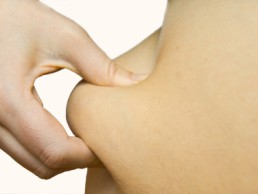
Q&A: Mole & Blemish Removal - Questions & Answers or FAQ's
Mole and Blemish Removal
Q. What is it?
A. Moles and blemishes are removed after a local anaesthetic has been applied to the area. The physician will remove the moles using one of a number of different methods. Most moles are removed with a scalpel whilst others are shaved off, frozen off with cold liquid nitrogen gas or removed using a precision laser. You will feel no pain or very little pain depending on the location of the mole or blemish and the removal methods used. Mole removal is quick and will not interfere with any plans you have for the day. Mole removal can be carried out for both cosmetic and medical reasons and your surgeon will discuss the details of each procedure.
Q. Who is mole removal for?A. Mole removal is requested by both men and women who are concerned about one or more moles on their body or face. Protruding moles for example can become irritated if constantly rubbed by clothes or caught when shaving. Many patients also request mole removal for cosmetic reasons if the removal will enhance their appearance. We have successfully treated many patients and can safely remove moles and blemishes from anywhere on the body or face,.
Q. Will I be left with scars?
A. Mole and blemish removal will usually leave a small scar. However, any scars will fade dramatically over the first year following the procedure. When a mole is removed, the skin surface is damaged and therefore needs to heal. A scab will form which will usually heal within a couple of weeks as long as it is treated with care. There will then be some inflammation of the area, but this will settle down and disappear within a few weeks. How noticeable a scar is largely depends on the size and location of the mole, but essentially scars are minimal.
Q. Are there any risks involved with mole and blemish removal?
A. Mole removal is a very simple procedure and considered very minor surgery. Thousands of patients have moles and blemishes removed each year without any problems or complications. Before the procedure takes place, your surgeon will discuss any risks involved and the best treatment that suits your circumstances and the mole or blemishes in question. Your surgeon will explain the entire procedure from start to finish together with any after-care that may be required.
Q. What happens following the removal procedure?
A. Mole removal is considered minor surgery and therefore recuperation time is almost zero. You may feel a little localised discomfort which can easily be relieved with painkillers. This discomfort should disappear after a couple of days, but your surgeon will discuss what to do should you have any discomfort or swelling that doesn’t disappear after a few days.
Q&A: Bioidentical HRT - Questions & Answers or FAQ's
Bioidentical HRT
What is Bioidentical HRT?
Bioidentical HTR is an innovative natural compound that mimics the molecular and chemical structure of hormones that are produced naturally in the body. There have been many studies on these natural hormone replacement therapies and they are deemed as entirely safe without the side effects that can be experienced with synthetic hormone replacement therapies. Bioidentical hormones are usually derived from plant sources and so contain no man-made ingredients. Many men and women turn to these therapies and have had much success in treating hormone imbalance.
Oprah Winfrey has been a proponent of bioidentical HRT saying; “After one day on bioidentical estrogen, I felt the veil lift”.
When should bioidentical HRT be considered?
Hormone imbalance can occur at any time in both men and women. As we age, our hormone levels can start to decline causing several symptoms that need treatment. Hot flushes, night sweats, loss of libido, fatigue, and weight gain are all unpleasant symptoms of hormone imbalance. Men may experience other ailments such as low energy, a slower metabolism resulting in weight gain, and loss of muscle mass. Your practitioner can prescribe a course of bioidentical hormones that will naturally replace the hormones lost and help you to get your energy and life back.
Bioidentical hormones have actually been used for many decades. Many studies have been carried out that prove that bioidentical estrogen and testosterone are not only safe, but have a positive impact on the human body and can help to protect against some cancers. If you experiencing any of the symptoms listed above you should seek help as soon as possible. A good time to start hormone replacement therapy is between 35 and 40 to get the full benefits.
What are the side effects of bioidentical HRT?
The good news is that side effects are very rare. Because bioidentical hormones are the same as those that occur naturally in the body this therapy is deemed very safe. Any side effects experienced usually result from dosage being too high.
What can I expect from a course of bioidentical HRT?
Taking a course of bioidentical hormones can have many benefits. Most patients report an enhanced quality of life with improved mental agility, a restored sense of wellbeing and improved energy levels. Libido levels are also restored and mood swings are diminished. Results differ depending on the symptoms you were experiencing, but overall the reports are very positive from men and women alike.



